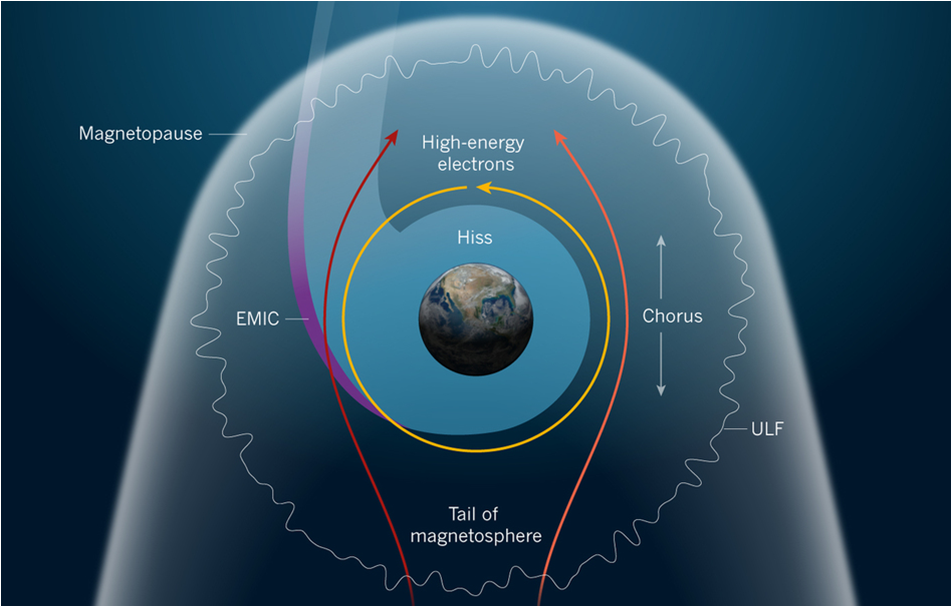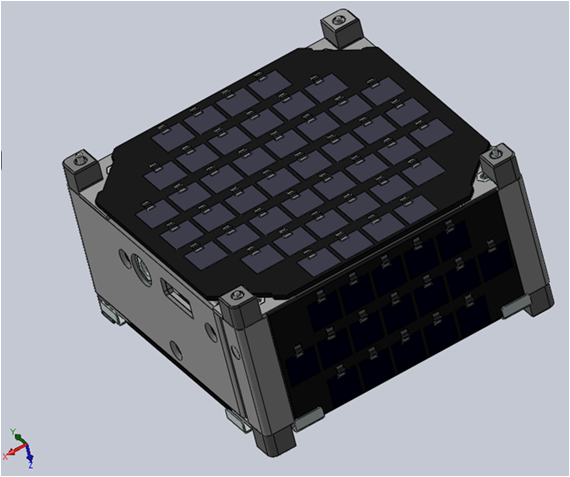My training began with essentially a week long IDL tutorial. Given the nature of my project, I will not be using IDL, however practicing a new language is always useful. I spoke to Dr. Klumpar and we have determined the scope of my project will consist of the orbit analysis for a constellation of cube satellites. This mission may be partnered with University of New Hampshire, who is interested in using such a mission to characterize Electromagnetic Ion Cyclotron (EMIC) waves at high latitude orbit inclinations. So far, I have been learning Satellite Tool Kit (STK) and have some rough orbit scenarios for both a 6 and 12 cube satellite mission. I have also been reading out of the Space Mission Analysis and Design (SMAD) book to understand constellation design in general. We will wait to further characterize the orbits until we have more information on the mission proposal being put forth by UNH.
 EMIC wave propagation in the Earth's magnetosphere.
EMIC wave propagation in the Earth's magnetosphere.
We had a telecon with UNH to talk about the multiple cubesat mission, which turned out to be a bit disorganized as it is challenging to get everyone in contact over the summer. In the mean time, I have been researching EMIC waves as a possible mission science objective. I just about have my STK scenarios wrapped up to simulate possible orbits for clusters of cubesats, and will continue to finalize them as we wait for more concrete information from UNH. So far, I have also practiced receiving telemetry data and sending mission ops commands for the passes of FIREBIRD 3 and 4. I also wrapped up the last couple weeks by performing an operational test for the telemetry data for the RadSat mission in the SSEL hardware lab.
 Snapshots of my STK simulations conducting orbital, solar panel, and down-link analysis.
Snapshots of my STK simulations conducting orbital, solar panel, and down-link analysis.
The guys at UNH seem a little disorganized with putting together a mission proposal by the end of this summer for a cubesat mission, and we have not received very much information from them for the parameters of the mission. After talking to Dave about this, we have decided it would be best to start developing our own cube satellite swarm mission based on reasonable parameters we can set ourselves. This will allow me to finish my orbital analysis for such a mission, as well as dive into the power, link, data, and communications architecture of a mission design through more of a systems engineering approach. Very excited to take my project in this direction for the remainder of the summer!
 SolidWorks 0.5U CubeSat Rendering
SolidWorks 0.5U CubeSat RenderingWe came up with an acronym that I'm really excited to present as the mission name: Space Weather and Radiation Multi-point Magnetometry (SWaRMM). SWaRMM has been coming along well, and I have just about all of the preliminary estimates for the design that I want, with the help of graduate students Kevin Zack and Matthew Handley, and SSEL systems engineer Keith Mashburn, and my advisor, Dave. The UNH guys also got back to us and reported that NASA will currently not allow a 0.5U cubesat size for the proposal and launch opportunity. However, Dave and other's see no reason why this should be the case, and will contact some NASA proposal reviewers to talk about the allowence of future missions such as SWaRMM. My goal for the rest of the summer will be to wrap up my mission design and write a paper on it so that it can be picked back up again another day. This last week I came down with a pretty bad cold, so hopefully I will be better by the time of my final presentation!
This summer has absolutely flown by! I have learned so much about the sun, cube satellites, and the aerospace design process. Being able to take some time to learn about cube satellite systems and aerospace design through a systems engineering approach has been an amazing experience. At the same time, studying solar physics throughout the summer has proven to be extremely interesting and valuable for my research interests. I would like to thank my advisor Dave Klumpar for the opportunity and all of the people in the SSEL who have helped me so such. Everyone I have met has been exceptionally nice and willing to help or answer any questions I have had, which created a great learning environment. I'll be sad to leave Montana, the friends that I've made, and all of the beautiful scenery!